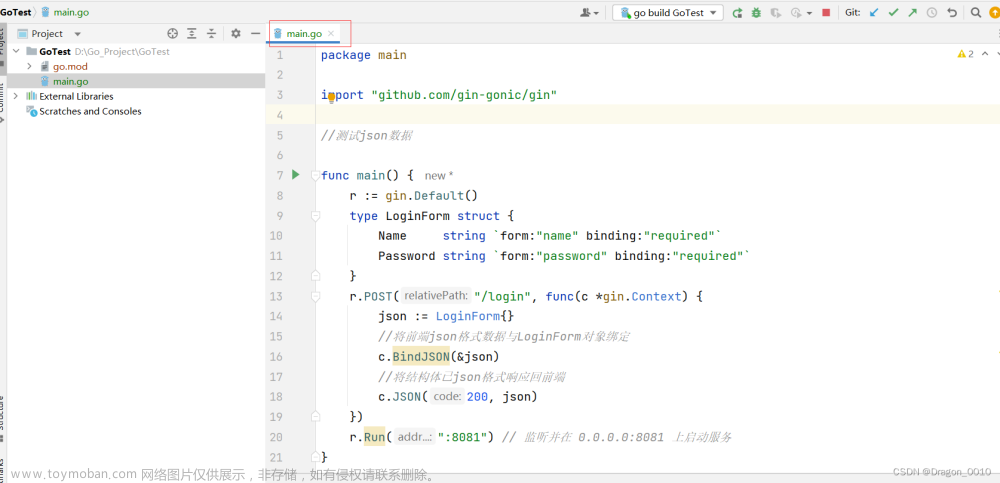一,json数据类型
J SON: JavaScript 对象表示法( JavaScript Object Notation) 。是一种轻量级的数据交换格式。 它基于ECMAScript的一个子集。 JSON采用完全独立于语言的文本格式, 但是也使用了类似于C语言家族的习惯( 包括C、 C++、 C#、 Java、 JavaScript、 Perl、 Python等) 。这些特性使JSON成为理想的数据交换语言。 易于人阅读和编写, 同时也易于机器解析和生成(一般用于提升网络传输速率)。
二,格式规范
- json以大括号起始和结尾
- 内容都是以键值对的形式存在
- 所有的键都是字符串
- 值的类型不一定,属于JavaScript 的基本数据类型
- 每个键值对以
,分割 - 最后一个键值对不加逗号
{
"name": "小明",
"age": 14,
"gender": true,
"height": 1.65,
"grade": null,
"skills": [
"JavaScript",
"Java",
"Python",
"Lisp"
]
} 结构体:
/* 类型定义 */
#define cJSON_False 0
#define cJSON_True 1
#define cJSON_NULL 2
#define cJSON_Number 3
#define cJSON_String 4
#define cJSON_Array 5
#define cJSON_Object 6
/* CJSON核心结构体 */
typedef struct cJSON {
struct cJSON *next,*prev; /* next/prev allow you to walk array/object chains. Alternatively, use GetArraySize/GetArrayItem/GetObjectItem */
struct cJSON *child; /* An array or object item will have a child pointer pointing to a chain of the items in the array/object. */
int type; /* 节点的类型,取值是上面的6种 */
char *valuestring; /* 如果类型是cJSON_String,那么值会被存到这里 */
int valueint; /* 如果类型是cJSON_Number,且是整型,那么值会被存到这里 */
double valuedouble; /* 如果类型是cJSON_Number,且是浮点型,那么值会被存到这里 */
char *string; /* 键*/
} cJSON;
三,JSON基本操作
Json序列化:可以理解为利用程序生成Json字符串的过程。
Json反序列化:可以理解为利用程序将已有的Json字符串解析出我们需要的值的过程。
举例:文章来源:https://www.toymoban.com/news/detail-571977.html
#include <stdio.h>
#include "cJSON.h"
#include <sys/types.h>
#include <sys/stat.h>
#include <fcntl.h>
#include <unistd.h>
#include <stdlib.h>
int main(int argc, char const *argv[])
{
#if 0
//反序列化
//读取文件--标准IO,文件IO
int fd = open("data.json", O_RDONLY);
if(fd < 0)
{
perror("open err");
return -1;
}
char buf[1024] = {0};
ssize_t len = read(fd, buf, 1024);
if(len < 0)
{
perror("read err");
return -1;
}
// printf("buf = %s\n", buf);
//反序列化动作
cJSON *root = cJSON_Parse(buf);
if(NULL == root)
{
printf("err parse\n");
return -1;
}
cJSON *item;
item = cJSON_GetObjectItem(root, "ver");
printf("%s = %s\n", item->string, item->valuestring);
cJSON *login = cJSON_GetObjectItem(root, "login");
item = cJSON_GetObjectItem(login, "pwd");
printf("%s = %d\n", item->string, item->valueint);
//解析数组节点
cJSON *data = cJSON_GetObjectItem(root, "data");
int count = cJSON_GetArraySize(data);
for (size_t i = 0; i < count; i++)
{
//取出数组的每一项,然后进行继续拆解
cJSON *tmp = cJSON_GetArrayItem(data, i);
item = cJSON_GetObjectItem(tmp, "key");
printf("key = %d\n", item->valueint);
}
cJSON_Delete(root);
#else
//序列化
cJSON *root = cJSON_CreateObject();
cJSON *age = cJSON_CreateNumber(10);
cJSON_AddItemToObject(root, "age", age);
//增加数组节点
cJSON *arr = cJSON_CreateArray();
cJSON_AddItemToArray(arr, cJSON_CreateString("JavaScript"));
cJSON_AddItemToArray(arr, cJSON_CreateString("Java"));
cJSON_AddItemToArray(arr, cJSON_CreateString("Python"));
cJSON_AddItemToObject(root, "skills", arr);
//输出内容
char *p = cJSON_PrintUnformatted(root);
printf("root = %s\n", p);
free(p);
cJSON_Delete(root);
#endif
return 0;
}
四,关键接口梳理
/* 类型定义 */
#define cJSON_False 0
#define cJSON_True 1
#define cJSON_NULL 2
#define cJSON_Number 3
#define cJSON_String 4
#define cJSON_Array 5
#define cJSON_Object 6
/* CJSON核心结构体 */
typedef struct cJSON {
struct cJSON *next,*prev; /* next/prev allow you to walk array/object chains. Alternatively, use GetArraySize/GetArrayItem/GetObjectItem */
struct cJSON *child; /* An array or object item will have a child pointer pointing to a chain of the items in the array/object. */
int type; /* 节点的类型,取值是上面的6种 */
char *valuestring; /* 如果类型是cJSON_String,那么值会被存到这里 */
int valueint; /* 如果类型是cJSON_Number,且是整型,那么值会被存到这里 */
double valuedouble; /* 如果类型是cJSON_Number,且是浮点型,那么值会被存到这里 */
char *string; /* 键*/
} cJSON;
/****************************通用接口****************************/
//把传入的字符串转成cJSON的结构(反序列化)
cJSON *cJSON_Parse(const char *value);
//把cJSON结构转成字符串(序列化),调用后需要配合free接口释放malloc的内存
char *cJSON_Print(cJSON *item);
//无格式化序列化,节省内存,调用后需要配合free接口释放malloc的内存
char *cJSON_PrintUnformatted(cJSON *item);
//释放节点的内存,防止内存泄露
void cJSON_Delete(cJSON *c);
/****************************反序列化相关接口****************************/
//获取数组的大小
int cJSON_GetArraySize(cJSON *array);
//从array数组中获取第item个子节点
cJSON *cJSON_GetArrayItem(cJSON *array,int item);
//获取object大节点名字叫string的子节点
cJSON *cJSON_GetObjectItem(cJSON *object,const char *string);
//判断object大节点中是否有名字叫string的小节点
int cJSON_HasObjectItem(cJSON *object,const char *string);
/****************************序列化相关接口****************************/
//创建一个普通节点
cJSON *cJSON_CreateObject(void);
//创建一个数组节点
cJSON *cJSON_CreateArray(void);
//把item节点增加到array的数组节点中
void cJSON_AddItemToArray(cJSON *array, cJSON *item);
//把item节点增加到object中作为子节点,item节点的键名为string
void cJSON_AddItemToObject(cJSON *object, const char *string, cJSON *item);
//创建各种类型的cJSON节点
cJSON *cJSON_CreateNull(void);
cJSON *cJSON_CreateTrue(void);
cJSON *cJSON_CreateFalse(void);
cJSON *cJSON_CreateBool(int b);
cJSON *cJSON_CreateNumber(double num);
cJSON *cJSON_CreateString(const char *string);
cJSON *cJSON_CreateArray(void);
cJSON *cJSON_CreateObject(void);解析
json 用到的函数,在cJSON.h中都能找到:文章来源地址https://www.toymoban.com/news/detail-571977.html
/* Supply a block of JSON, and this returns a cJSON object you can interrogate. Call cJSON_Delete when finished. */
extern cJSON *cJSON_Parse(const char *value);//从 给定的json字符串中得到cjson对象
/* Render a cJSON entity to text for transfer/storage. Free the char* when finished. */
extern char *cJSON_Print(cJSON *item);//从cjson对象中获取有格式的json对象
/* Render a cJSON entity to text for transfer/storage without any formatting. Free the char* when finished. */
extern char *cJSON_PrintUnformatted(cJSON *item);//从cjson对象中获取无格式的json对象
/* Delete a cJSON entity and all subentities. */
extern void cJSON_Delete(cJSON *c);//删除cjson对象,释放链表占用的内存空间
/* Returns the number of items in an array (or object). */
extern int cJSON_GetArraySize(cJSON *array);//获取cjson对象数组成员的个数
/* Retrieve item number "item" from array "array". Returns NULL if unsuccessful. */
extern cJSON *cJSON_GetArrayItem(cJSON *array,int item);//根据下标获取cjosn对象数组中的对象
/* Get item "string" from object. Case insensitive. */
extern cJSON *cJSON_GetObjectItem(cJSON *object,const char *string);//根据键获取对应的值(cjson对象)
/* For analysing failed parses. This returns a pointer to the parse error. You'll probably need to look a few chars back to make sense of it. Defined when cJSON_Parse() returns 0. 0 when cJSON_Parse() succeeds. */
extern const char *cJSON_GetErrorPtr(void);//获取错误字符串到了这里,关于JSON数据交互格式的文章就介绍完了。如果您还想了解更多内容,请在右上角搜索TOY模板网以前的文章或继续浏览下面的相关文章,希望大家以后多多支持TOY模板网!










